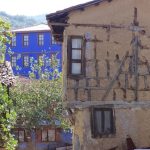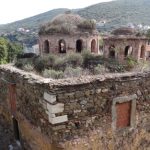If you don’t mind being a little away from the main city-centre attractions then one of the nicest areas to stay in Bursa is Çekirge, which is where the thermal hotels and the best of the hamams are to be found. It’s a leafy hillside suburb, quieter, airier and more open than the town centre. Frequent dolmuşes to and from the centre mean that it’s never difficult to get to the sights while the pretty village of Misiköy is only a short drive away.
In Turkish çekirge means “locust”. However, the name of the suburb probably comes from that of an individual buried just in front of the tomb of Sultan Murad I who was called Çekirge Sultan.
Around Çekirge
Approaching Çekirge from the town centre you will see on the left-hand side of the road the Çelik Palas Hotel which Atatürk had supplied with thermal water to supply its hamam. Right beside it is the 19th-century wooden house that he used as a base when in Bursa; it contains a small museum. A little further along the road the Orman Müzesi (Forest Museum) housed in the elegant 19th-century Saatçi Köskü. The museum’s contents are not especially exciting but it’s worth popping inside to see the painted ceilings on the top floor of the house. In the pretty garden there is also a delightful wooden summer-house. It’s kept locked but you can peer through the windows to see yet more attractive murals.
Across the road the large Kültür Park is home to Bursa’s Archaeology Museum which is in need of an overhaul but contains some of the finds from Bithynian sites nearby.
A little further along the road there’s a monument on the right-hand side of the road commemorating the shadow-puppet characters, Karagöz and Hacivat. Facing it is a small museum to shadow puppetry and the people who have made the puppets and worked to keep the tradition alive.
Eventually you arrive in Çekirge Square with the excellent Eski Hamam (Old Hamam) in a dip to the right of the road. The hamam is still open to visitors with separate sections for men and women. It has been restored to offer the cleanliness and comforts expected by guests at the Kervansaray Hotel that now owns it.
The road then winds uphill to the part of town which has most of the accommodation. It’s up here that you’ll also find the unexpected Hüdavendigar Cami, built for Sultan Murad I between 1363 and 1366. An extraordinary building, it looks more like a fortified palace than a mosque and is made from a fine mix of brick and stone with the odd Byzantine capital reused in the two-storeyed portico. Step inside and you’ll find a marble fountain placed at the centre of the inverted T-bar ground plan that is such a feature of Bursa mosques.
To the left of the mosque the Cık Cık (Gir Gir) Hamamı still survives, as does the imaret (soup kitchen) that was once part of the mosque complex. Across the road the sultan is buried inside a lovely türbe (tomb), which, like those of Osman and Orhan in the town centre, had to be rebuilt after an earthquake in 1855. A smaller tomb is said to contain the remains of Çekirge Sultan, a local madman who was a contemporary of the sultan and gave his name to the suburb.
Sleeping
Boyugüzel Termal Hotel. Tel: 0224-239 9999
Transport info
Dolmuşes to Çekirge leave from the north side of Atatürk Caddesi at the Setbaşi end. Take one labelled “Askeri Hastanesi” if you want to be taken right up to the mosque; those labelled just Çekirge will drop you in the main square beside the hamam, leaving you to walk up the hill.

